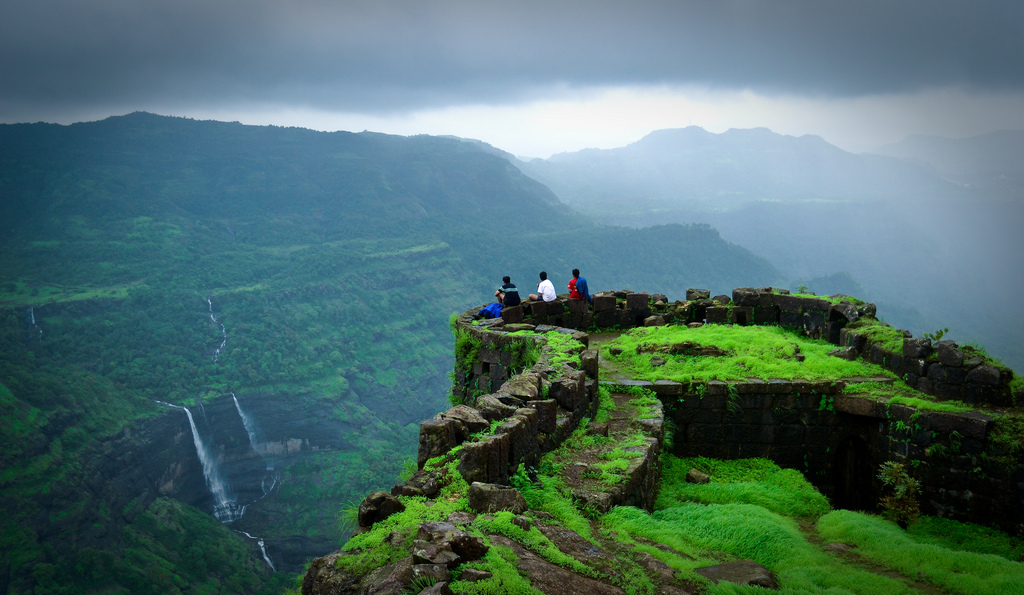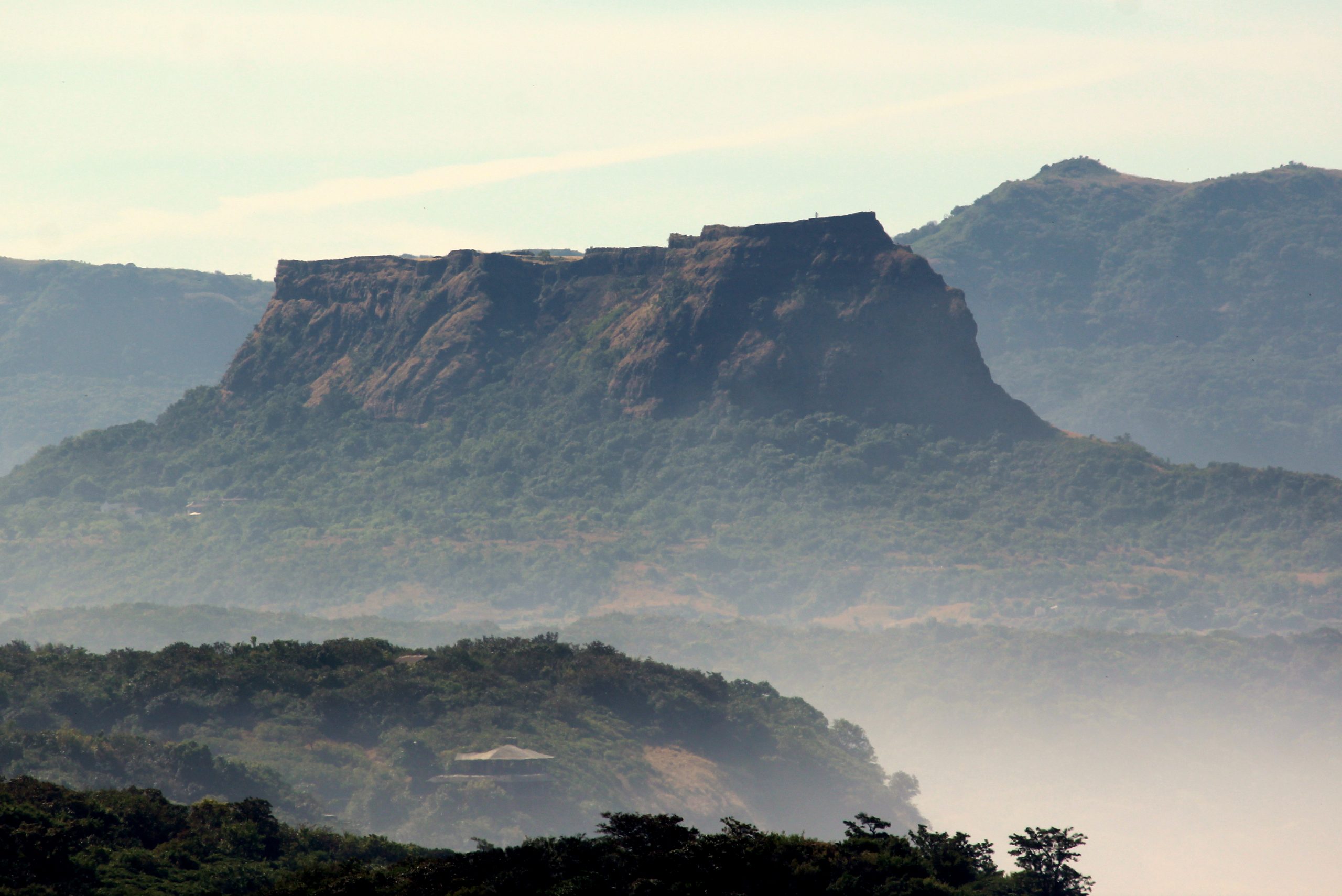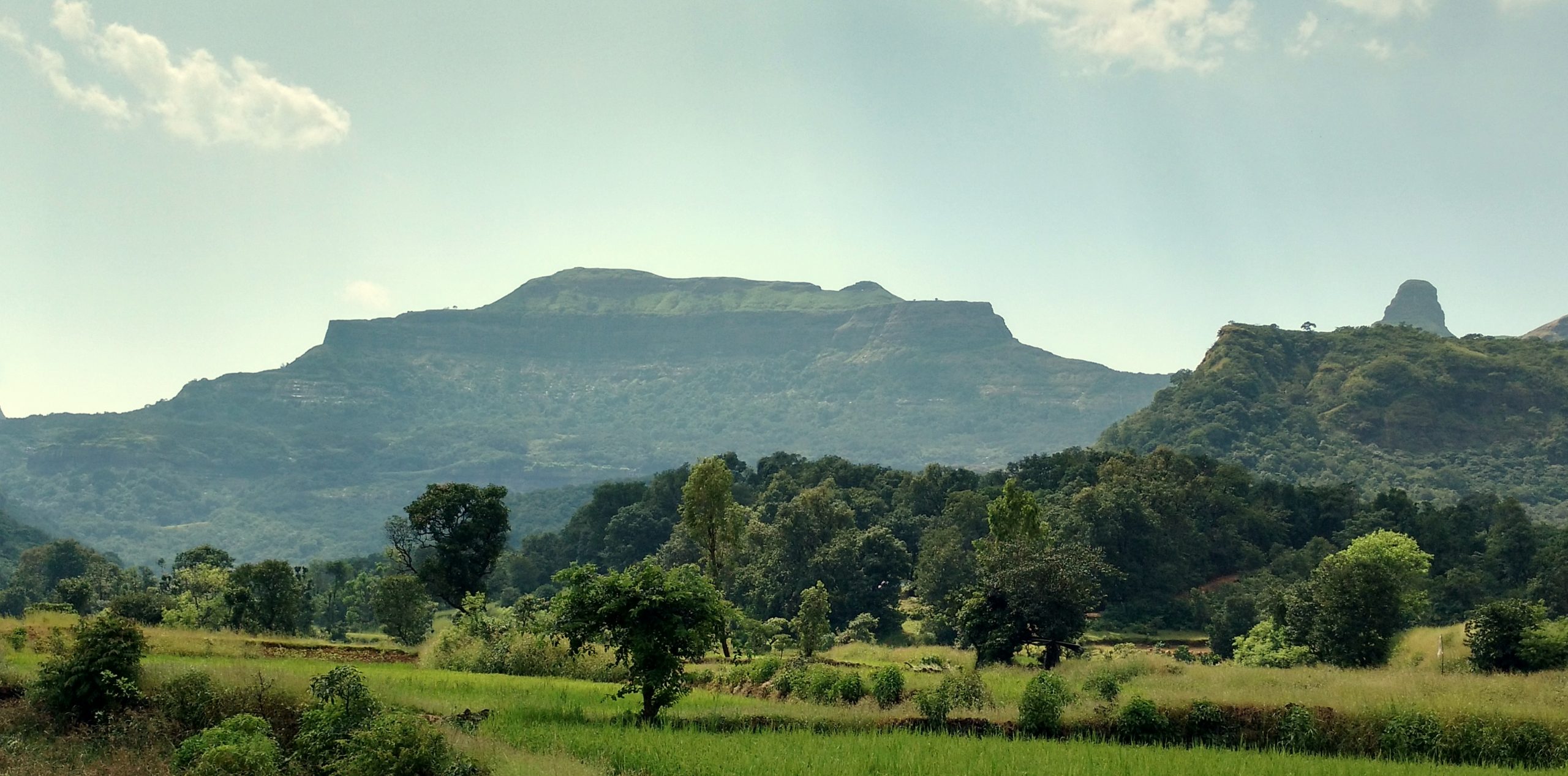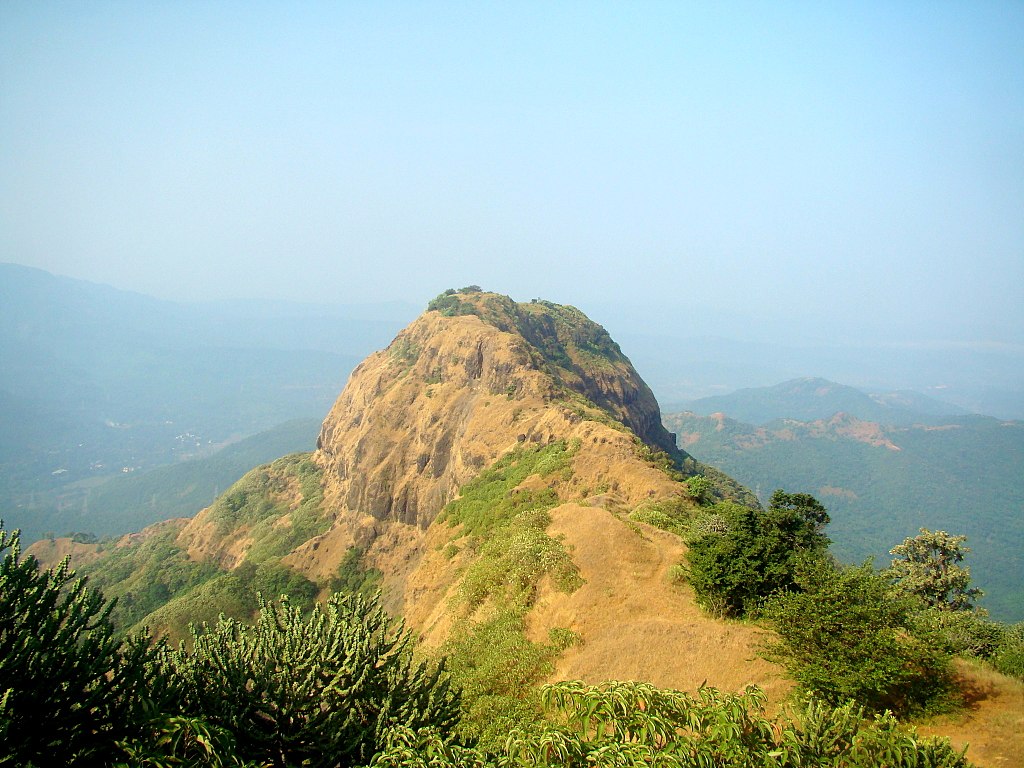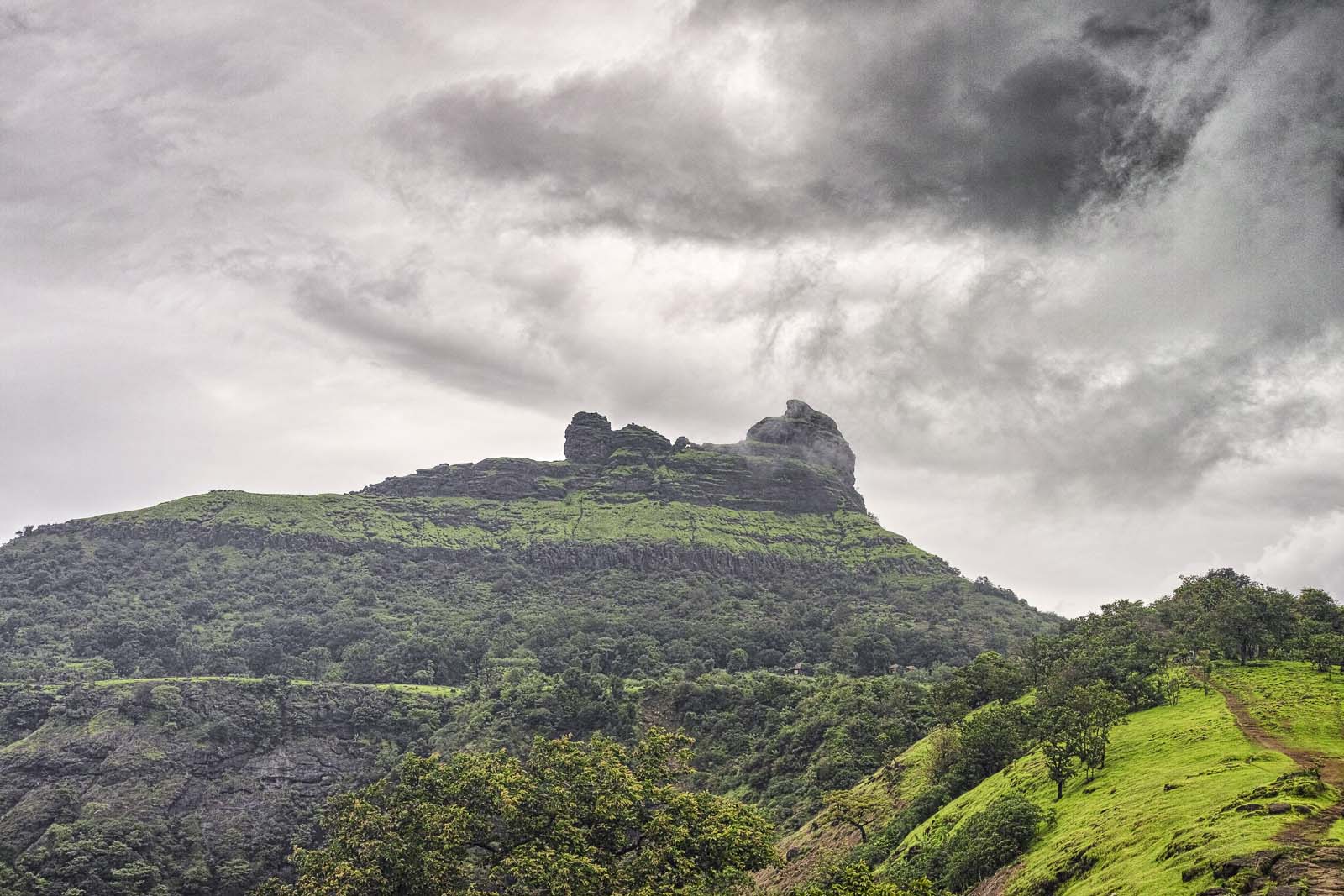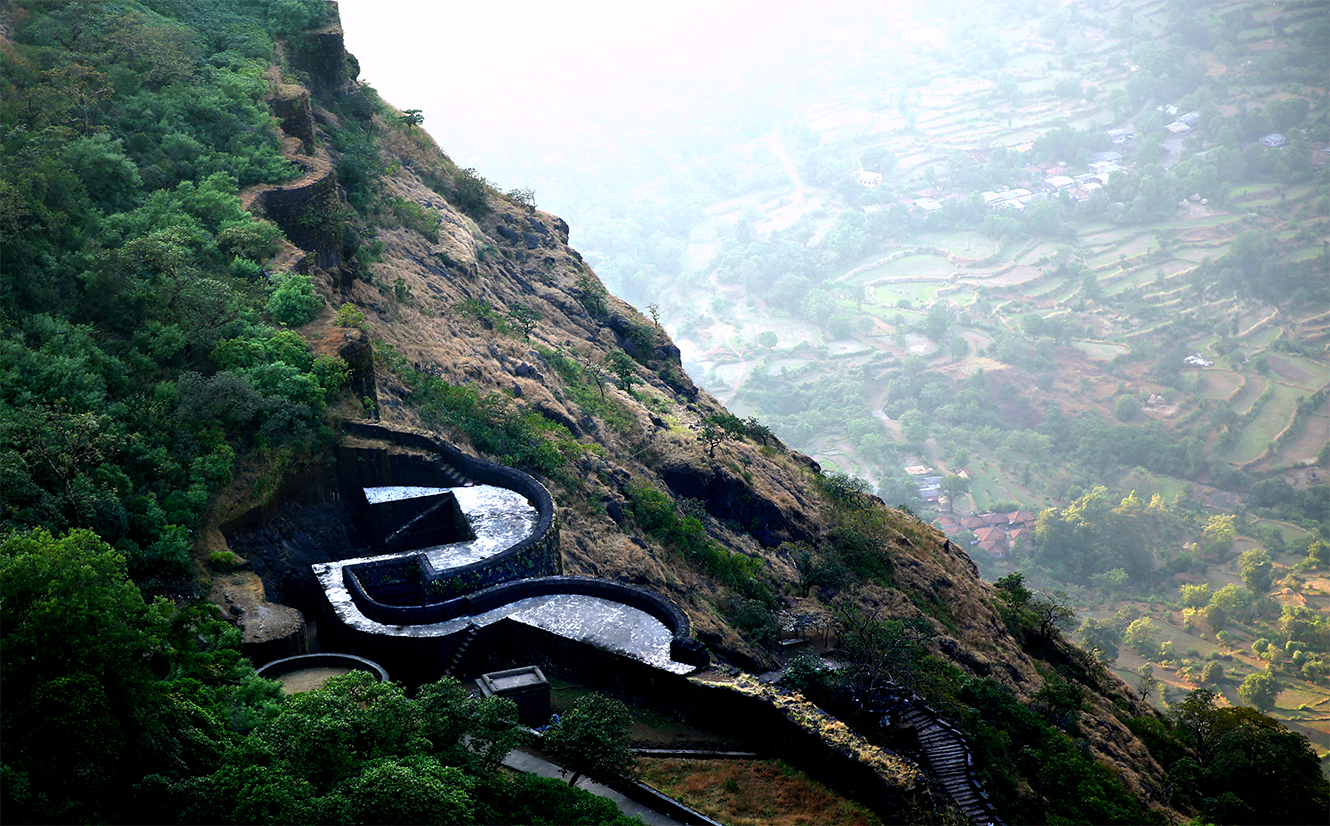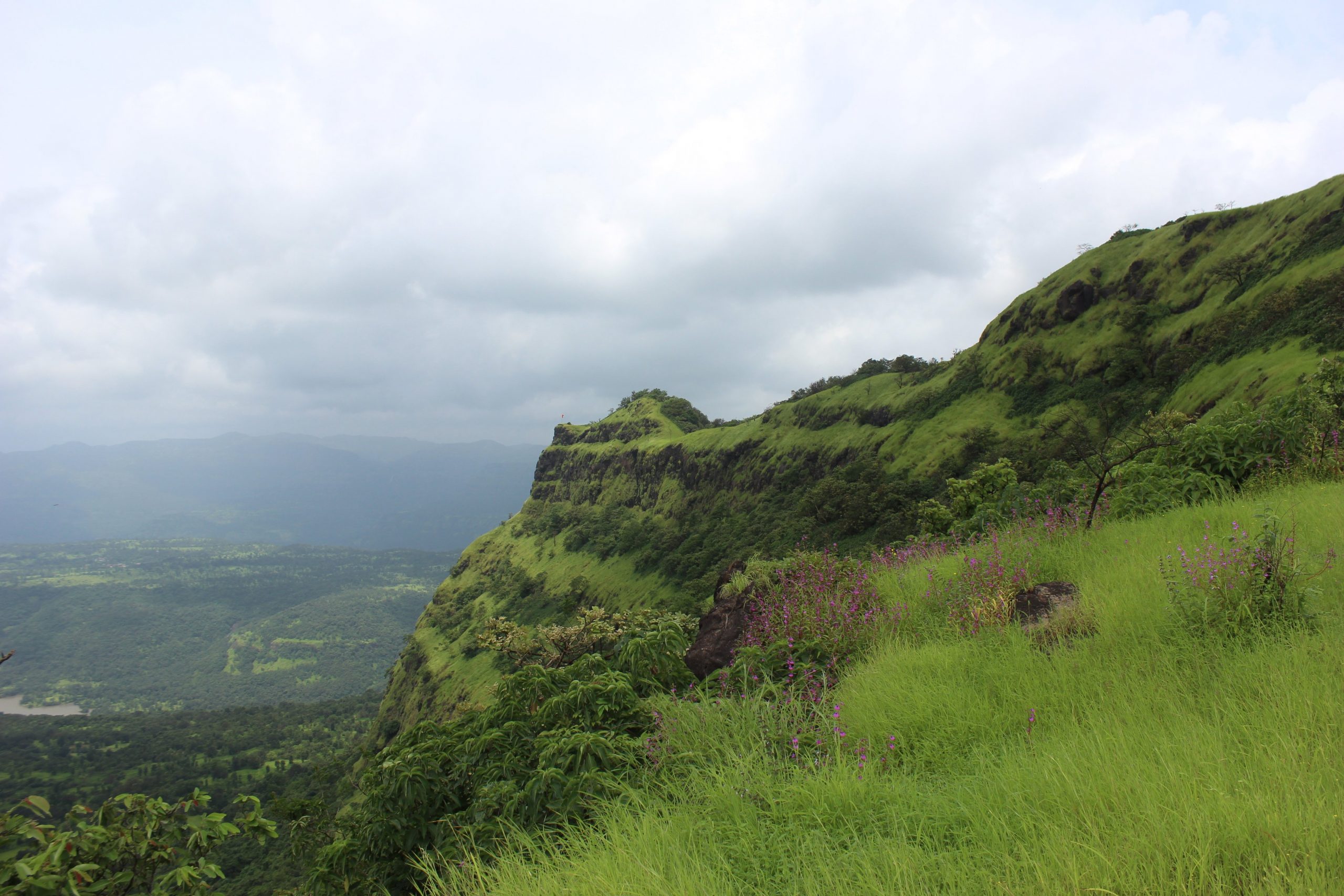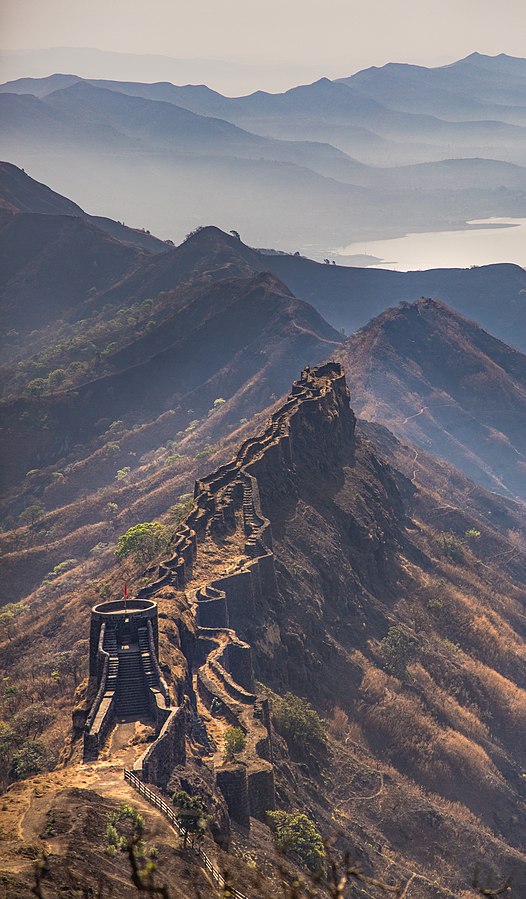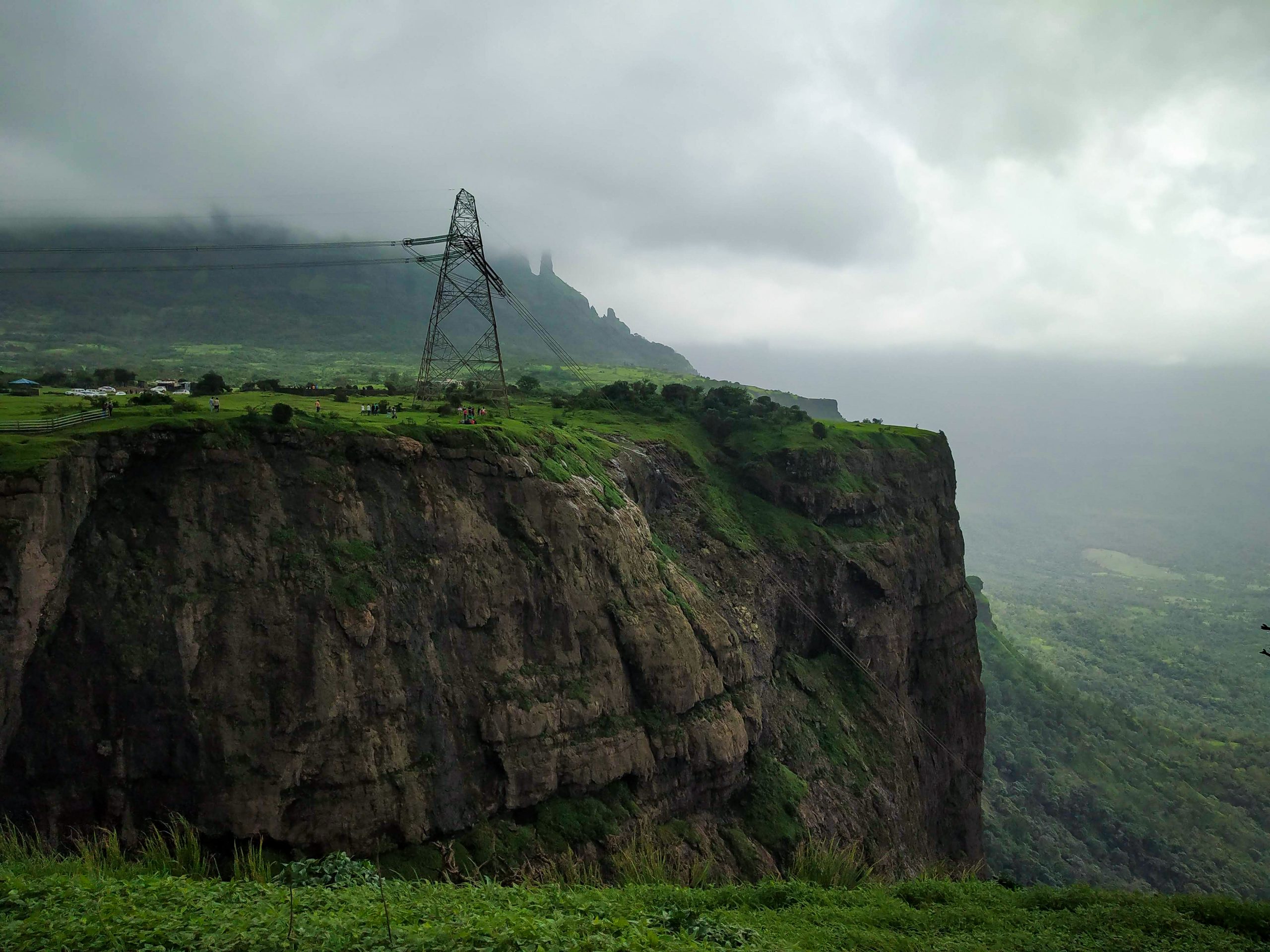15 Best Fort Treks in Maharashtra Which Are Absolutely Amazing!
Trekking is a great outdoor activity for those who enjoy trying new things. Maharashtra is known for its numerous forts, each of which has a fascinating history. Trekking to them will satisfy your desire for adventure while also allowing you to learn more about the fort’s architecture, history, and current state. Furthermore, these forts frequently provide a spectacular bird’s eye view of the surrounding area. So, here are some of the best fort treks in Maharashtra that you can go on.
1. Rajmachi
Shrivardhan and Manaranjan are two fortified peaks on Rajmachi. A plateau between the two peaks is reached after a half-hour climb from the base village of Udhevadi. Rajmachi Fort is a well-known tourist destination known for its historic ruins and strategic location. It is 15 kilometres from Khandala and Lonavala, two hill stations in Maharashtra. It consists of two fortresses, Shrivardhan and Manaranjan, and is surrounded by a vast plateau. The Bor Ghat, a major trade route between Mumbai and Pune, can easily be seen.
Source: Wikimedia Commons
Trek
The trek route is entirely up to you. If you are new to trekking, the Lonavala route is the best option. The trek from Lonavala takes a long time. The trek begins in Rajmachi’s base village. Because it is surrounded by forest and greenery, the trek route will be exciting for you. The journey takes approximately 4 to 5 hours to reach the final destination. If you’re looking for a thrilling adventure, the Kondhane route is the way to go. The Rajmachi trek is a little more challenging than the Lonavala trek route. The fort is reached after a steep climb that takes between 2.5 and 3 hours.
History of the Fort
The historical Rajmachi fort complex, built by the Satavahanas, has a fascinating history. In 1657, Shivaji Maharaj captured this fort, as well as the surrounding forts, from Bijapur’s Adilshahi ruler. In 1704, the Mughal Emperor Aurangzeb retook the fort from the Marathas. The Marathas regained control the following year, and Shahu Maharaj later gave the Rajmachi fort to Kanhoji Angre in 1713. When the Marathas were defeated in 1818, the British took control of the Maratha territories as well as the Rajmachi fort.
2. Kalavantin Fort Trek
The Kalavantin Fort, also known as Durg, is next on our list of the best fort treks in Maharashtra. It is located near the Prabalgad Fort on the Old Mumbai-Pune route.
Source: Stringfixer
Trek
You must trek up the mountain’s rock-cut steps that zigzag their way up to the fort on this route. The steps are exposed, and climbing them provides a panoramic view of the surrounding area. The fort is located at the summit of the mountain, approximately 2,300 feet above sea level. Finally, you arrive at the fort, which is surrounded by greenery and ts view makes it one of the best fort treks in Maharashtra. If you want to trek to this fort during the monsoon season, it’s best to avoid it.
The last stretch of the Kalavantin Durg trek is the most difficult, as it requires traversing steep stairs and climbing a vertical rock patch to reach the pinnacle, which stands at an incredible height of 685 metres. Depending on one’s fitness level, the trek can take anywhere from 3 to 5 hours to complete. The final stretch to the pinnacle adds to the challenge of completing the journey.
History of the Fort
The fort was built for a queen named Kalavantin, according to legend. The Adivasi people of Prabalmachi village follow the tradition of dancing at the top of the Kalavantin fort during the Holi (Shimga) Festival. In the early nineteenth century, freedom fighter Umaji Naik used it as a secret hideout. The history of Kalavantin Durg is frequently confused with that of the nearby Prabalgad Fort, which was built around 530 BC as a 685-meter (2,300-foot) high stone spire during the Bahmani Sultanate. The fort was taken over by the Ahmadnagar Sultanate in 1458 AD. It was conquered by the Mughal Empire in the following centuries, and it was the site of numerous battles between various dynasties.
3. Korigad Fort Trek
Korigad is a Maharashtra hill fort. The fort, which is located in the Pune district, rises to a height of about 2800 feet above the ground. The fort’s entire wall is completely intact, despite the fact that not much of the fortifications are still standing. It is possible to walk around the perimeter of the park, which is 2 kilometres long. Within the fort, there are caves and water cisterns.
Source: Wikimedia Commons
Trek
The Korigad Fort trek route is simple and well-marked all the way to the top of the fort making it one of the easiest fort treks in Maharashtra. The trek to Korigad Fort begins at either a temple or a small forest. The climb to the top of Korigad Fort takes only 45 minutes. Korigad Fort Trek is one of the most popular one-day treks in the Mumbai, Thane, and Pune areas. The best time to visit Korigad Fort is during the monsoon season. For beginners and first-timers, Korigad Fort is the best and most ideal trek.
History of the Fort
The Korigad Fort, also known as Koraigad or Koarigad, is located on Lonavala’s southern outskirts. The fort of Korigad is estimated to be 1500 years old. In 1657, the forts of Lohagad, Visapur, Tung, and Tikona were forcibly taken by the Chatrapati Shivaji Maharaj. The British, however, took this fort from the Marathas on March 14, 1818. Aamby Valley, a planned city, is built on the fort’s southern and eastern sides. We can see a spectacular view of water flowing down historical stairs during the monsoon season. The Lonavala Mountain Range encompasses Koraigad Fort. Tung Fort, Pawna Lake, and Aamby Valley City can all be seen from Korigad Fort.
4. Lohagad Iron Fort Trek
The Lohagad Fort (Iron Fort) is a historical fort located along the Sahyadri hills in the Lonavala region of Maharashtra, 11 kilometres from Lonavala, 66 kilometres from Pune, and 114 kilometres from Mumbai. It is a popular heritage site in Maharashtra and one of the best tourist fort treks in Maharashtra.
Source: Wikimedia Commons
Trek
The quickest and easiest route is to drive up to Lohagadwadi’s base village and then walk up the fort’s stone steps. Another one comes from Bhaje, a village about 5 to 6 kilometres from Malavali. Gaumukh Khand can be reached by walking from the village of Bhaje. This is where one might become perplexed. We must make a right turn here because a left turn will lead us to the fort of Visapur. We must continue walking after making a left turn until the fort’s stairwell is visible.
History of the Fort
The Lohagarh Fort is a one-of-a-kind historical site. ‘Lohagad’ means ‘fort of iron,’ and the fort is virtually impenetrable, as its name suggests. It is surrounded on all sides by deep moats, and it was once widely believed that the fort could only fall “if a crocodile swallowed up all the water in the moat.” The fort, which was built in the 1730s, is now mostly used for government offices and a museum.
5. Ratangad Fort Trek
Ratangad is an ancient hill fort located at Ratanwadi village in the Ahmednagar district of Maharashtra, 6 km from Ratanwadi, 23 km from Bhandardara, 183 km from Pune, and 197 km from Mumbai. It is one of Maharashtra’s best fort treks in Maharashtra and a great place to visit near Mumbai and Pune.
Source: Wikimedia Commons
Trek
Starting on the trek route, the terrain is a fairly steep uphill climb that will put your endurance to the test. Because the rote is rather jagged and it’s easy to miss your route if you go during a fog season, it’s recommended that you hire a guide for a safe and quick climb to the fort. The jungle climb is difficult, but relief comes in the form of two plateaus that appear in the middle of the journey. Climbing the Ladders found in the last leg of the trek will be a breeze, and will lead you to the Tryambak darwaja, the Fort’s official entrance.
History of the Fort
Ratangad is a 400-year-old fort that Chatrapati Shivaji Maharaj conquered during his reign. It is located in Ratanwadi, its base village, and looks out over the Bhandardara.
6. Jungli Jaigad Fort Trek
The fort is located near Satara’s Koyna Lake. The best time to visit the fort is in the winter when the weather is mild and there is no chance of rain. The fort is located at a height of 2957 feet above sea level, so you can imagine the view from the top. Because you’ll be surrounded by forest, it’s likely that you’ll see a variety of animals and birds.
Source: Wikipedia
Trek
The Jungli Jaigad fort trek is one of the most interesting treks through dense jungle, providing adventure seekers with a thrilling experience. It is also regarded as one of Maharashtra’s best treks. The trek from the base village of Navja near Koyna Nagar takes 3–4 hours. When you reach the top, you’ll be rewarded with a breathtaking view of the Koyna dam backwaters as well as a stunning view of the Kumbharli Ghat. Winter is the best time to trek to Jungli Jaigad fort. Due to the presence of wildlife, camping in the fort is not recommended.
History of the Fort
Bijapur Kings are said to have built Jaigad fort in the 16th century. It later passed into the hands of Sangameshwar’s Naiks. He was in charge of 7-8 villages and 600 troops. In 1583 and 1585, he defeated the combined forces of Bijapur and the Portuguese. Jaigad was one of the ten forts given to Kanhoji Angre by Balaji Vishwanath Peshwa in 1713. This fort was taken by the British without a fight in June 1818.
7. Irshalgad Fort Trek
Irshalgad Fort, which is 3700 feet above sea level, is the sister fort of Prabalgad Fort. During the Bahmani Sultanate, it was built. The attraction is surrounded by dense forest and offers a variety of exciting hiking trails. The Irshalgad pinnacle is also a great place to go mountaineering. The panoramic view of the Western Ghats from the vantage point at the top of the attraction is well worth the trip.
Source: Wikimedia Commons
Trek
The nearest railway station is Karjat, from which you must hire a taxi to reach Irshalwadi village. One can drive up to Chowk/Chauk village in a private vehicle if travelling by road. After that, it takes about an hour to get to the fort. The climb takes about 2 hours and the descent takes about 1.5 hours. The best months to go on the trek are August to March, avoiding the peak summer and monsoon seasons.
History of the Fort
The name Irshalgad is misleading because it refers to a pinnacle rather than a fort. It’s a rare occurrence throughout history. It’s possible that it served as a watchtower for the area between Manikgad and Prabalgad. Shivaji Maharaj conquered the region of Kalyan and Bhiwandi up to Rairi in May 1666. At the time, Irshalgad was probably under Maratha’s rule. It shares a border with Prabalgad. On January 23, 1972, Kumar Prakash Durve died after falling from this vantage point. Every year on January 26th, all trekkers from the Mumbai – Thane region gather here to commemorate this day.
8. Raigad Fort Trek
The captivating Raigad Fort is perched on the Sahyadri mountain range in Mahad, Maharashtra, at an elevation of around 820 metres. Because deep valleys surround the other three sides, the majestic fort is only accessible from one side via a 1737-step pathway. For the Marathas, the fort is a source of great pride and serves as a reminder of their bravery and audacity. The Raigad fort is more than just a tourist attraction; it is a sacred pilgrimage site that bears the imprints of Chhatrapati Shivaji’s grand vision of Hindavi Swarajya. While most of it is now in ruins, the fort still boasts of the Marathas’ valiant history.
Source: Wikimedia Commons
Trek
If you enjoy trekking, you can either climb the stairs or take the bus to Pachad. To get to the fort, you’ll have to climb 1737 steps. However, there is also the Raigad Ropeway, an aerial tramway that takes 4 minutes to reach the fort. There is a ropeway to reach the Raigad Fort for those who do not enjoy trekking. It is only 4 minutes long and has a diagonal length of 760 metres and a steep ascent of 420 metres. The ropeway ascends to the top of this breathtaking fort through whistling winds and spectacular lush greenery. A visit to the museum and a film show is included in the price, in addition to the ropeway.
History of the Fort
Chandrarao Mores built this magnificent fort in 1030. The fort of Rairi was taken from the royal house of Chandrarao Mores, a Cadet dynasty from the ancient Maurya Dynasty, by Chhatrapati Shivaji Maharaj in 1656. The fort of Rairi was renovated and expanded by Shivaji, who renamed it Raigad, which means “King’s Fort.” It was also regarded as the Maratha kingdom’s capital. After capturing the Raigad Fort, Shivaji Maharaj built Fort Lingana near it. The fort was the target of a British East India Company armed expedition in 1765. Finally, on May 9, 1818, it fell under British rule.
9. Kavlya Fort Trek
Even though it is located in Varandha Ghat, a popular tourist destination, the Kavlya fort trek is one of the least visited fort treks in Maharashtra. The Varandha Ghat is a major thoroughfare that connects Raigad in the Konkan with Pune in the Ghats. The fort of Kavlya was built to watch over this route.
Source: Wikimedia Commons
Trek
Even though it is located in Varandha Ghat, a popular tourist destination, the Kavlya fort trek is one of the least visited forts in Pune, Maharashtra. The Varandha Ghat is a major thoroughfare that connects Raigad in the Konkan with Pune in the Ghats. The fort of Kavlya was built to watch over this route.
History of the Fort
There isn’t much information about the Kavlya fort’s history. It was constructed to protect and guard the Varandha Ghat. Because the Varandha Ghat pass was heavily used by traders, the British government constructed a paved road in 1857. The fort was split into two sections.
10. Sondai Fort Trek
The Sondai Fort trek is another one of the most visited fort treks in Maharashtra during the monsoon season. The lush greenery blankets the area. Because the Sondai trek is still relatively unknown, the experience will be peaceful and serene. It is located near Karjat and offers a beautiful view of the Morbe dam and Matheran range. You can stop at the Sondewadi village for a cup of tea while trekking to the fort. During the trek, you will also see cisterns full of water, as well as an idol of Sondai Devi at the summit.
Couldn’t find an image in the public domain
Trek
The Sondai fort trek is a moderately difficult trail that takes about an hour to complete. During the monsoon, the trail becomes a little more difficult because the rock steps become slick. The fort can be reached via two routes. The one from Sondewadi is preferable because the one from Wavarle has a more difficult approach because it passes through densely forested terrain.
History of the Fort
The Sondai Fort was built as a watchtower to keep an eye on the surrounding areas. The presence of a temple dedicated to the Goddess of Sondai at the peak of the mountain gives it its name. Because the temple has no proper structure, the tree above it is considered its wall.
11. Rajgad Fort Trek
Rajgad Trek is one of the most beautiful fort treks in Maharashtra. It is the king of forts, as its name implies. The fort stands out among other forts in the western ghats due to its rich history and mesmerising architecture. It is located near Pune at a height of 4,514 feet. This fort was constructed on the hill Murumb Devacha Dongar, which has a diameter of approximately 40 kilometres. Because of the fort’s massive size, it was difficult to lay siege to it, allowing the Marathas to make strategic decisions.
Source: Wikimedia Commons
Trek
Take a step back in time on this exciting trek from Pune to the Padmavati temple and the ruins of the Ancient Fort. The Rajgad Trek is a moderately difficult trek that begins in Pune’s Gunjavane Village and ends at the Rajgad Fort.
History of the Fort
It is a symbol of the Maratha army’s victories and battles, and it honours the feats of Chhatrapati Shivaji, a famous Indian ruler. The fort was originally known as Murumbdev and was built during the reign of the Maratha rulers. This fort was renovated and renamed only after Chhatrapati Shivaji relocated his capital to Rajgad.
12. Naneghat Fort Trek
Naneghat is a mountain pass in the Western Ghats of Maharashtra, India, located 30 kilometres from Malshej Ghat. It is one of Maharashtra’s most beautiful trekking destinations, located near Vaishakhare village on the Kalyan-Ahmednagar Highway. It is also one of the must-visit fort treks in Maharashtra for adventure seekers.
Source: Wikimedia Commons
Trek
The trekking point to the Naneghat starts from the Ahmednagar-Kalyan road, with Vaishakhare as the base village. The hiking trail is 4.5 kilometres long from the beginning to the top, and it takes about 2.5 hours to complete one side. The trek up Naneghat is moderately easy, and even inexperienced hikers can complete it. The path’s entire length is made up of geographically diverse terrains.
The plateau is interesting to explore and provides breathtaking views of Jivdhan Fort and Bhairavnath Temple. There are numerous resting spots at various locations where one can easily capture the scenic beauty of the surrounding area. Apart from trekking, Naneghat can also be reached via a motorable road that runs from the Ghatghar region all the way to the top.
History of the Fort
Naneghat, also known as Nanaghat or Nana Ghat, was a part of an ancient trading route during the reign of the Satavahana and is located at an elevation of 2,600 feet (c. 200 BCE – 190 CE). Through Junnar, it connected the Konkan coast communities with the Deccan high plateau. The name Nane Ghat comes from the words nane, which means ‘coin,’ and ghat, which means ‘pass.’ This path was used as a tollbooth to collect tolls from traders crossing the hills. It’s one of the most well-known Malshej Ghat tourist attractions.
13. Harishchandragad Trek
Harishchandragad is a historical hill fort in Maharashtra’s Ahmednagar district, located 8 kilometres from Khireshwar, 15 kilometres from Malshej Ghat, 50 kilometres from Bhandardara, 166 kilometres from Pune, and 218 kilometres from Mumbai. It is one of Maharashtra’s most popular heritage sites, and one of the most popular fort treks in Maharashtra as part of Malshej Ghat tours.
Source: Wikimedia Commons
Trek
The fort, which is located at an elevation of 1,424 metres, used to play an important role in guarding and controlling the surrounding area. The fort, which is one of the most popular tourist attractions in Malshej Ghat, was built in the 6th century during the reign of the Kalchuri dynasty. During this time, the citadel was constructed, and various caves were most likely carved out in the 11th century AD.
In the 14th century AD, sage Changdev meditated here. The fort later fell under the control of the Mughals, who were defeated by the Marathas in 1747 AD. Human relics from the Microlithic period have been discovered here. Various Puranas, such as the Matsya Purana, Agni Purana, and Skanda Purana, mention Harishchandragad’s fort.
History of the Fort
There are three popular trekking routes to the fort: through Khireshwar Village, through Nalichi Vaat, and through Paachnai Village.
The trek route from Khireshwar village to Tolar Khind is a straight trail that takes 2 to 2.5 hours one way. Khireshwar village is approximately 7 kilometres from Malshej Ghat Bus Stop, which is located near Khubi Phata Village. The caves can be seen from Junnar Darwaza, which is located near the base village. This path leads directly to Tolar Khind. Following Tolar Khind, there is a 100-foot rock patch with iron railings for trekkers’ safety. A straight path leads to Harishchandreshwar Temple after crossing a rock patch, with small hills and streams in between.
Harischandragad can also be reached via Paachnai village, which is 48 kilometres from Bhandardara. To get to Harishchandragad, one must trek 5 kilometres from Paachnai. The trekking path is easy and beautiful, with views of the forest’s natural beauty. The climb to the top of Harischandragad takes about 3 hours. There are numerous rocky outcroppings and steep climbs along the way.
The third path, which begins in Belpada village and leads to Sadhleghat, is designed specifically for hikers. The route from here is extremely difficult and passes through Sadhleghat. Climbing a straight rock patch with handholds is required here. The trail continues to be rocky and uphill from here. The fort is about 19 kilometres from Belpada village and takes 9 hours to reach (on the way). At the peak, camping is permitted.
14. Tikona Fort Trek
Tikona Fort, also known as Triangle Fort, is a dominant hill fort located in the Maval region of Lonavala in Maharashtra, 21 kilometres from Lohagad Fort, 25 kilometres from Lonavala, 53 kilometres from Pune, 135 kilometres from Mumbai, and 22 kilometres from Tung Fort. The fort is one of the best fort treks in Maharashtra, as well as a popular day-trip destination between Pune and Mumbai. Tikona Fort, also known as Vitandgad Fort, is situated at a height of 3633 feet above sea level.
Source: Wikimedia Commons
Trek
The village of Tikona Peth is the closest to the Tikona Fort trek. A motorable road runs from Tikona Peth village to the fort’s base, which is 2 kilometres away. The trek takes 1 to 1.5 hours from the fort’s base and is moderately difficult. There is a cave on the way to the top, followed by a statue of Lord Hanuman. The entrance to the bastion is reached via a path adjacent to the cave. From here, one must climb 100 or so steep stairs to reach the top of the fort. There are two sections to the steps. A fixed rope with bolts provides support while climbing.
History of the Fort
Unlike the many other forts in the state, this mighty Fort is devoid of historical information. In 1585 AD, the Nizam Shahi dynasty conquered the fort and annexed it to the Nizam domain. Shivaji Maharaj conquered Tikona, along with the forts of Karnala, Lohagad, Mahuli, Songad, Tala, and Visapur, in 1657 AD, bringing the entire Konkan, which had been Nizam territory, under his control. According to the Treaty of Purandar, which was signed on June 12, 1665, the Tikona fort was surrendered to the Mughals, but it was later recaptured by the Shivaji Maharaj in 1670 AD.
15. Harihar Fort Trek
Harihar Fort or Harihargad is a small hill fort in the Upper Vaitarana range near Trimbak in Maharashtra’s Nashik district, located 22 kilometres from Trimbakeshwar and 45 kilometres from Nashik. The fort, also known as Harshgad or Harishgad, is one of the popular monsoon fort treks in Maharashtra.
Source: Wikimedia Commons
Trek
Harihargad, at an altitude of 1120 metres (3676 feet), is located on a triangular rock with all three sides vertical and is only accessible from one side, via a 200-foot-high rock-cut staircase. The rock-cut steps at an angle of 80 degrees that one must negotiate to enter the fort are the most fascinating aspect of this trek. Despite the fact that it is a vertical ladder, the steps have niches for proper grip while ascending. There are a total of 117 steps. It’s a thrilling experience to ascend and descend through this patch.
The entrance to the fort, also known as the Darwaja, can be reached after climbing up this first set of stairs. After that, there is a very narrow path that must be navigated with extreme caution. To reach the top of the fort, one must again climb 100 steep stairs. A tapering plateau with a raised level in the middle characterises the fort. On the plateau, there is a small temple dedicated to Lord Hanuman and Lord Shiva. In front of the temple, there is a small pond with potable water. Within the fort, there is a small palace with two rooms. Along one side of the palace, there are five cisterns, one of which contains potable water.
Nirgudpada, about 22 kilometres from Trimbakeshwar, is the starting point for the Harihar Fort trek. To get to the Harihar Fort, visitors must trek 4 kilometres from the base village. The trek to the top of the fort is moderate and takes about 2 hours.
History of the Fort
The Ahmadnagar Sultans owned several forts, including Harish Fort. Captain Briggs paid it a visit in 1818 AD. Shahaji gave the Mughals Harishgad, Trimbakgad, Tringalwadi, and a few other forts in 1636 CE. On the fall of Trimbak in 1818 CE, Harishgad was one of the 17 strongholds that surrendered to the British.


